Marco Rose is one of the most highly-rated coaches to emerge from the Bundesliga in recent years, with his achievement this season in leading Borussia Monchengladbach into the knockout rounds of the UEFA Champions League serving as a great example of his talent and ability. Rose came to Monchengladbach from Red Bull Salzburg, a club which has become famous for pressing and counter-pressing, and the 44-year-old honed his tactical philosophy during his time in Austria.
Winning the ball high up the pitch when dispossessed is one of the most important concepts of Rose’s team. However, this does not mean that Gladbach press without a plan. A better way to describe his team without the ball is ‘strategic’.
With a PPDA (passed allowed per defensive action) of 11.63, they are the 9th highest in the league, suggesting that the intensity of the press is not as high as you might have expected. This figure is even higher in the Champions League – 15.09, further proving that Gladbach’s press is a lot more structured and intelligent than many people may believe.
In this scout report, we will be covering their mid-block when out of possession, as well as their pressing strategies. While Gladbach have changed formations on occasion this season, as well as engaged opponents higher or further back, as the situation demanded, the general ideas and tactics have remained largely consistent.
Midblock
As mentioned in the above analysis, their press involves the use of a mid-block as a prerequisite. With the following concepts, Gladbach try to obtain several objectives before pressing under controlled conditions:
- Creating a numerical overload
- Staying compact as a unit
- Closing half-spaces
- Covering the opposition pivots
- Creating multiple layers
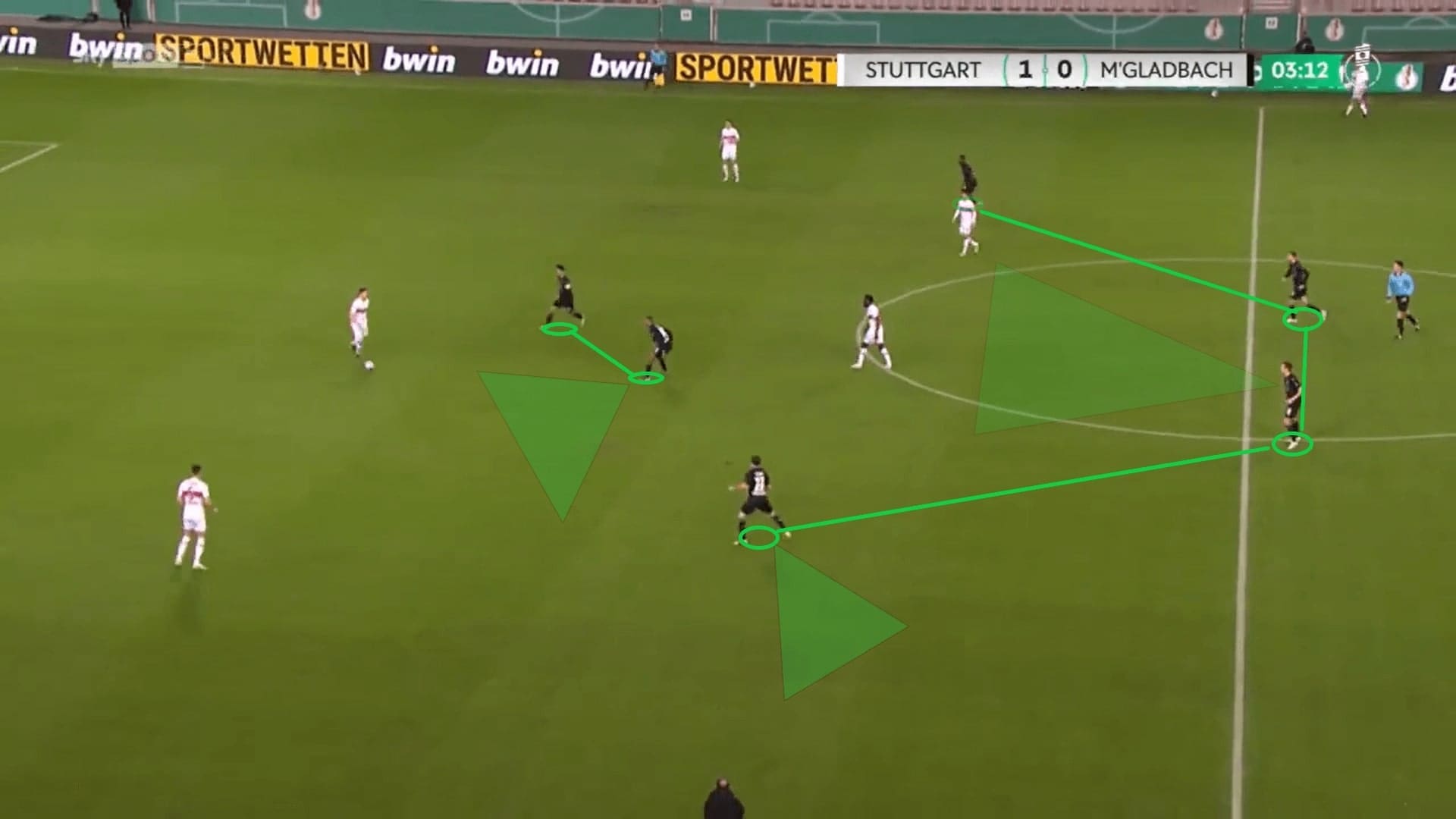
The above image shows Gladbach’s mid-block in a 4-2-2-2 shape, with Lars Stindl usually joining the striker, and therefore creating four layers or lines for Gladbach. Additionally, they create a six-man central overload, containing the Stuttgart pivots to a large extent.
By keeping the wingers narrow in the half-spaces, and higher than the midfielders, they tightened the distances between the first layer and the midfield. The Gladbach players also use their positioning and body orientation to close the vertical passing lanes in this zone to force the Stuttgart players to pass the ball sideways. For example, the opposition centre-backs would not be able to pass to their narrow wingers or offensive midfielders in front of the Gladbach back four easily in such a scenario.
The green triangles indicate the spaces for each role to defend. The strikers, of course, need to defend the spaces in front, but also have to prioritize covering the pivots. Meanwhile, the wingers protect the half-spaces as explained. The central midfielders, in addition to covering the centre, also need to be alert to defend space in front, whenever there is a chance for the opposition to progress where the strikers cannot close the central spaces.
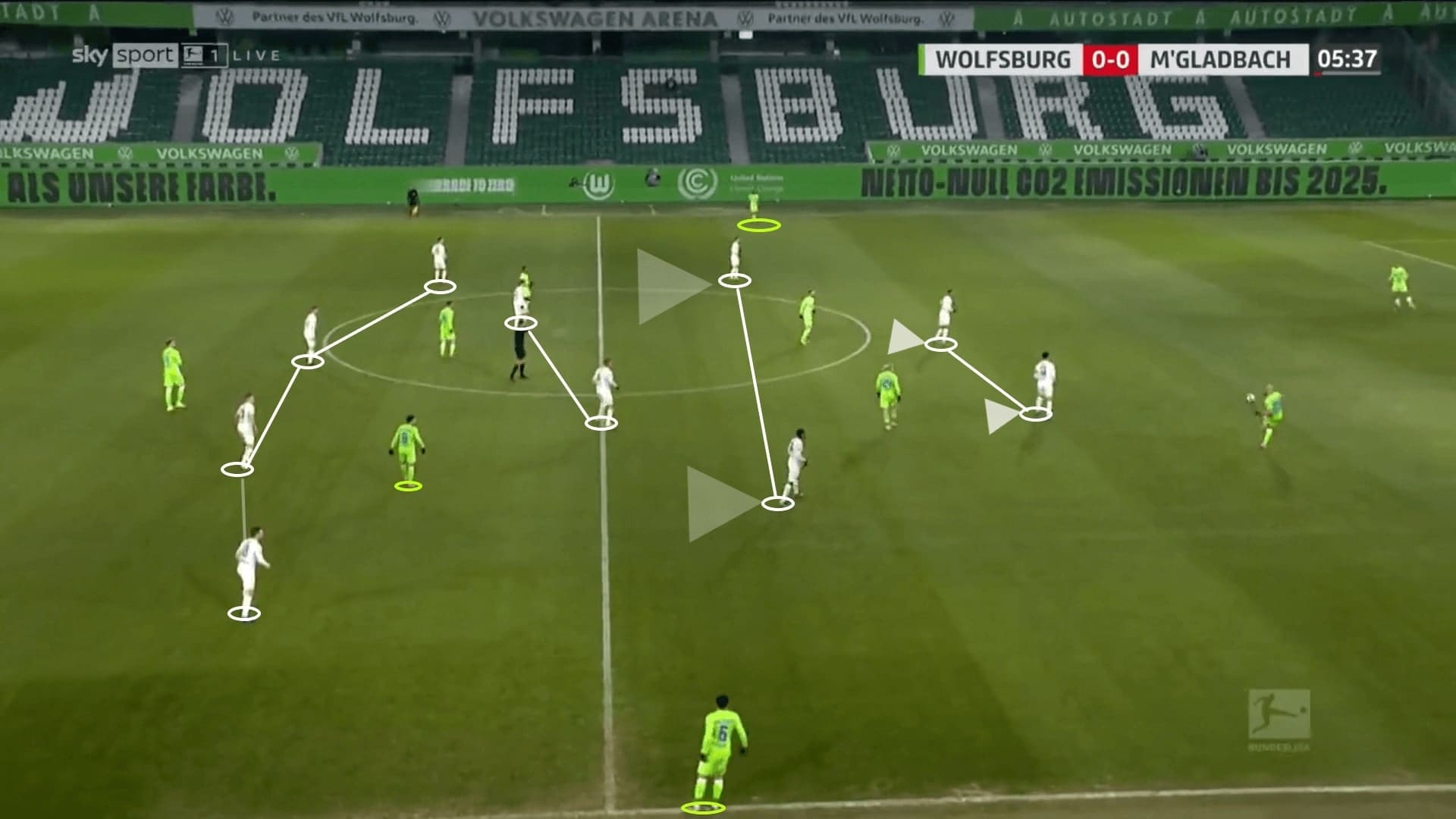
The above image shows us a clearer picture of the entire structure of the team and how compact they are. In the 4-2-2-2 shape, the defensive line must push up and be tighter to the midfielders, trying to reduce space in front as much as possible. They will need to apply offside traps as well, as seen in the example.
Against teams playing out from the back with two pivots, the first layer may need to pay higher attention to spaces behind them, with each of them covering one player. Meanwhile, the wingers are still staying narrow to shadow the half-spaces – the right-winger is covering Renato Steffen (#8) here, for example. The midfielders, generally, need to cover a lot of ground in Rose’s system, although this may vary a little depending on the opponent and the situation.
Notice that they will leave the wide zones completely free. Even with Wolfsburg positioning the full-backs wide on the touchlines initially, Gladbach would just ignore them because the top priority is not allowing central penetrations.
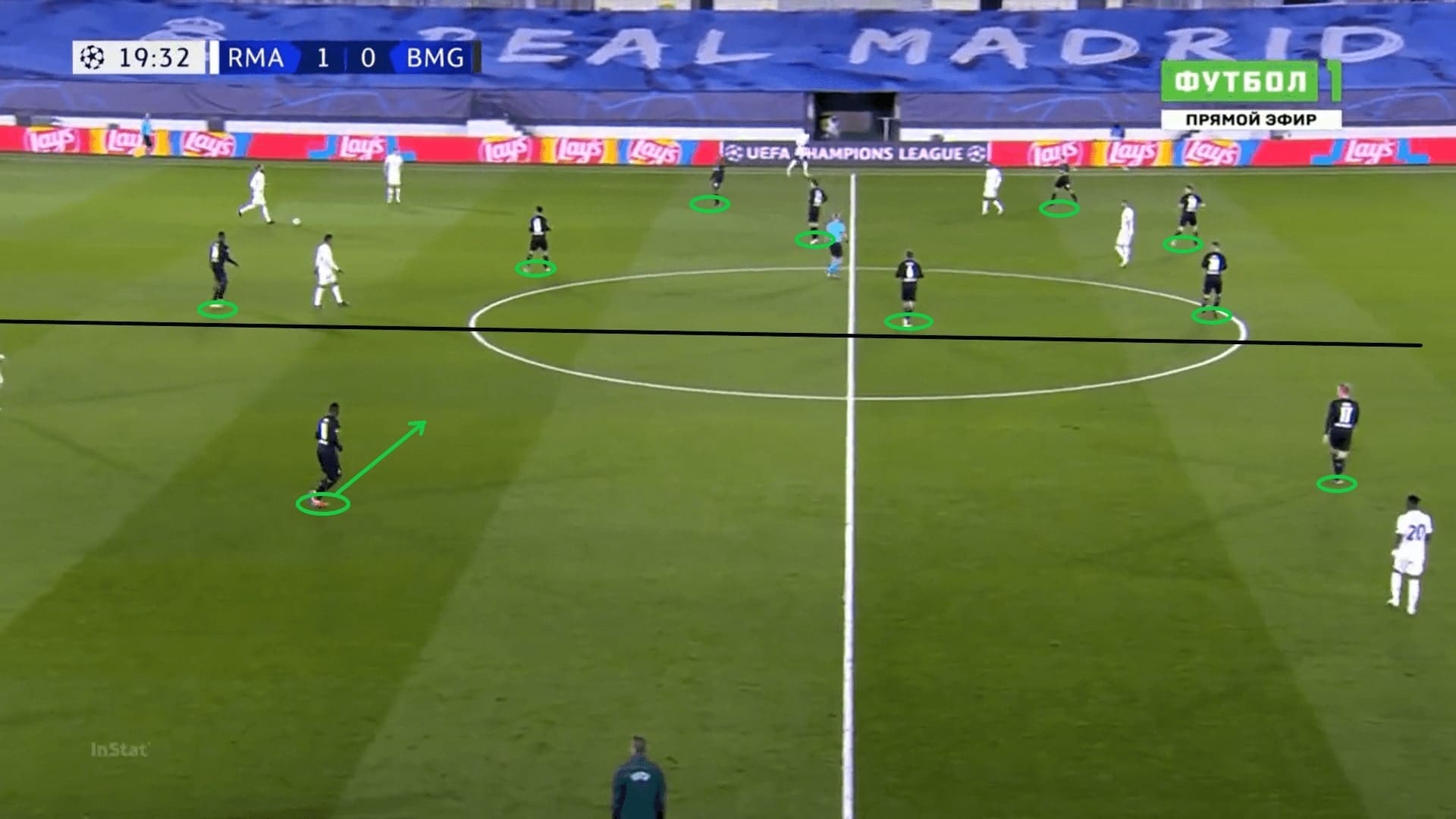
The concept of overloads can be extended to different reference points. The examples we have been showing are about spaces, but the ball is also one of them. When the ball is moved wider, Gladbach shift the block to the ball half to ensure that there are more numbers there than the opposition.
For example, against Real Madrid, a team with an excellent ball-playing centre-back in Sergio Ramos, they will need to defend on the right a lot. The above image shows how Gladbach’s block is already oriented towards the right half of the pitch when Ramos looks to bring the ball out of the back. They have eight players in that half, more than Madrid’s six. When the opposition tries to progress the ball on this side, space is tightly controlled making it easier to recover possession.
The concept of compactness is also shown here. Apart from the defensive block moving as a unit to the ball half, we can see the left winger (#10 Marcus Thuram) also moving into central areas. This is not only to defend spaces centrally, but also a potential trigger for counter-attacks. If there is a possession turnover, the French winger could be found quickly, initiating a counter-attack through a position with the highest strategic importance. If he stayed wide on the left instead, it would be very difficult for him to get on the ball immediately upon Gladbach recovering possession.
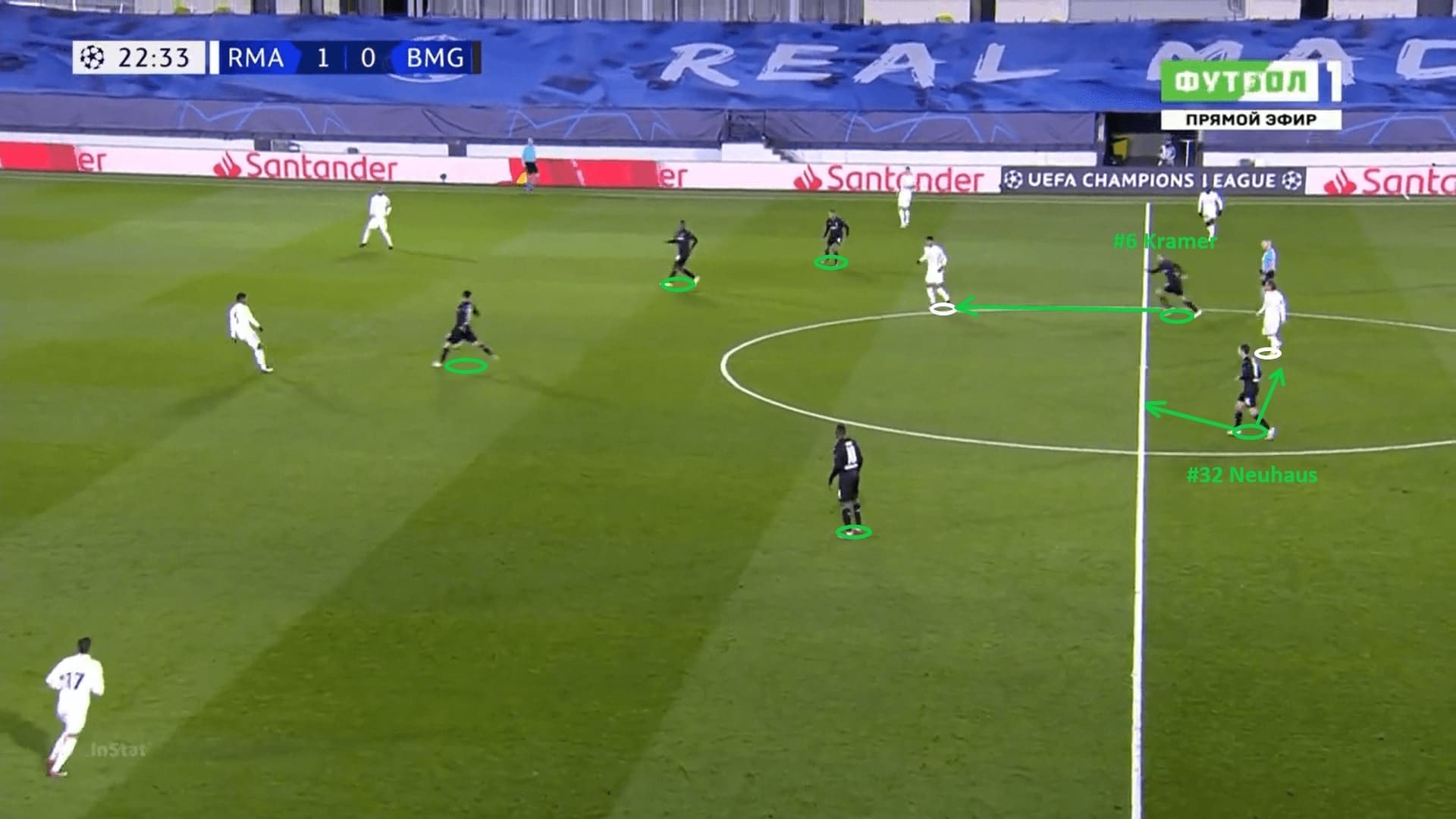
The last example in this section shows the roles of the midfielders. The main objective is to control central spaces well, potentially triggering turnovers and counter-attacking opportunities.
Since the strikers cannot cover the pivots in every situation, sometimes the space behind them is large when they are attracted to the centre-backs. Then, the midfielders need to be alert to cover the pivot, as Christoph Kramer does in the above example. We can also see how the midfield partnership needs to work in this situation, with Florian Neuhaus aware of Kramer’s movement and therefore positioning himself to cover.
Pressing and traps
We used the word “strategic” to describe Gladbach, and this mostly refers to their pressing. Instead of committing their players in a high line, going after the ball and attacking the ball like Jesse Marsch’s RB Salzburg, Rose’s team are more careful when applying pressure.
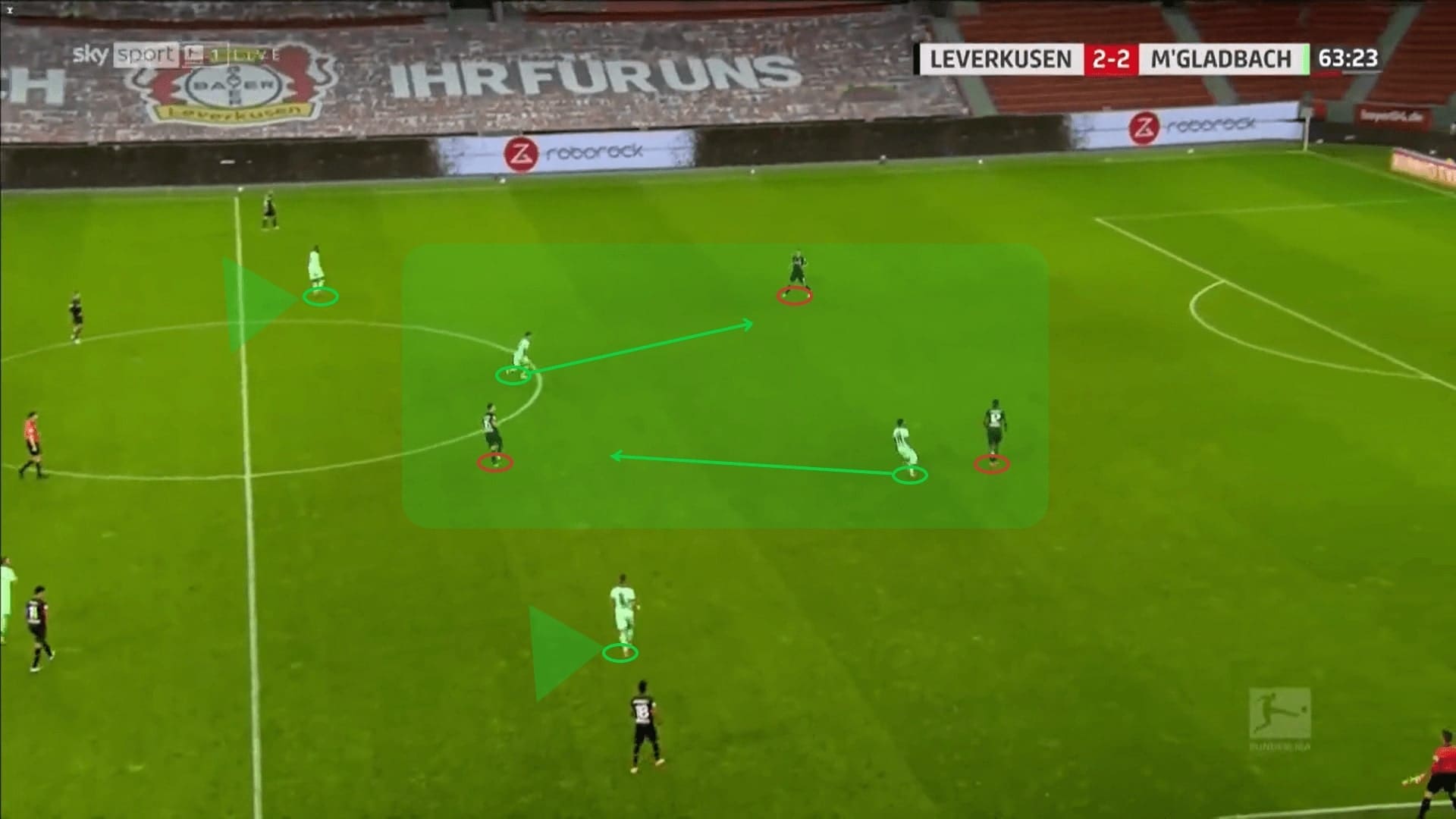
The above image shows Gladbach’s strategy to press the centre-backs. Usually, teams play out from the back with a 2-1 shape, which means the pivot stays in another layer to create a 3v2 overload. Rose knows the numerical situation, but he is usually quite reluctant to add an extra man in this area to reach numerical equality. Hence, Gladbach need to defend smartly.
In the highlighted green zone, we have showed Gladbach’s underload. The priority is to cover the pivot, which is why Gladbach are happy to let a centre-back have the ball under little pressure, but they work to cut out the passing angles to the pivot.
When one striker pressed the centre-back, forcing an exchanged pass to the other centre-back, he should not chase the ball. Instead, he should retreat and get back to spaces in front of the pivot. This was another striker’s job to press the centre-back. By starting the run in front of the pivot initially, this second presser should be able to shadow the passing lane when applying the pressure. Hence, the passing options are limited and more predictable. If the opponents played vertically, the wingers are ready to intercept. If they go wide, they are fallen into the trap as we would explain it later.
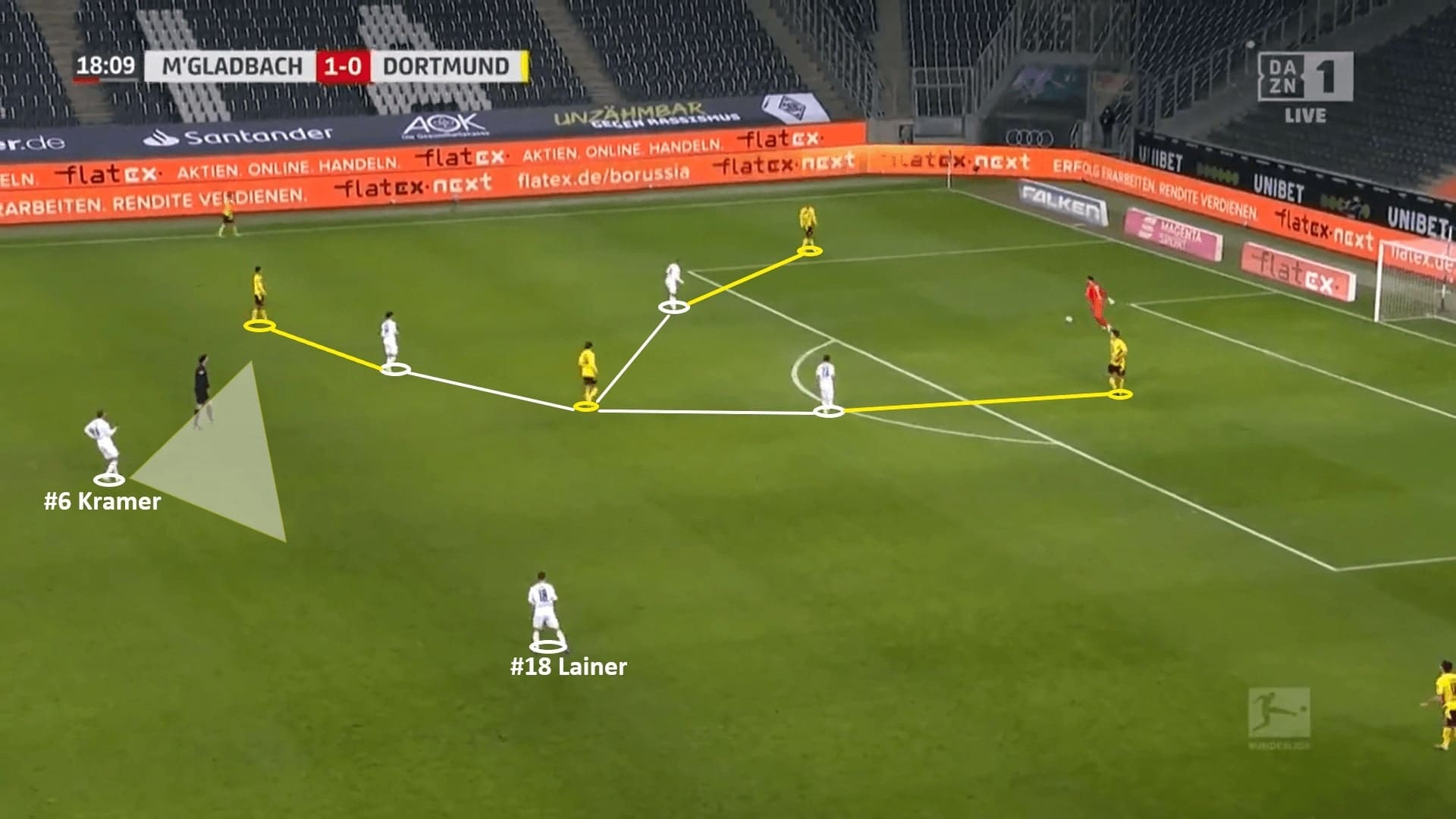
But there are some exceptions. There are cases where Gladbach would try to bait the opposition and set a pressing trap on their pivot. This brought another tactical concept of the head coach – pressing from multiple angles.
The trap would need the collaboration of midfielders and strikers because of the need to control spacing tightly. Gladbach recently tried to play with a back three, but their pressing concepts are largely the same. This image shows their approach against Dortmund. When the strikers are a bit attached to the centre-backs, splitting wider and leaving the vertical channel opened, the keeper would think the pivot is free.
However, the midfielders had great awareness to cover spaces behind the first layer. At the meantime, pay attention to the white lines, which indicates the distances of Gladbach players with the pivot – roughly equal! This means once the ball is played into this player, there could be at least three players to press him from three angles. The remaining unclosed spaces were even covered by Lainer and Kramer, so there was no way of dribbling out.
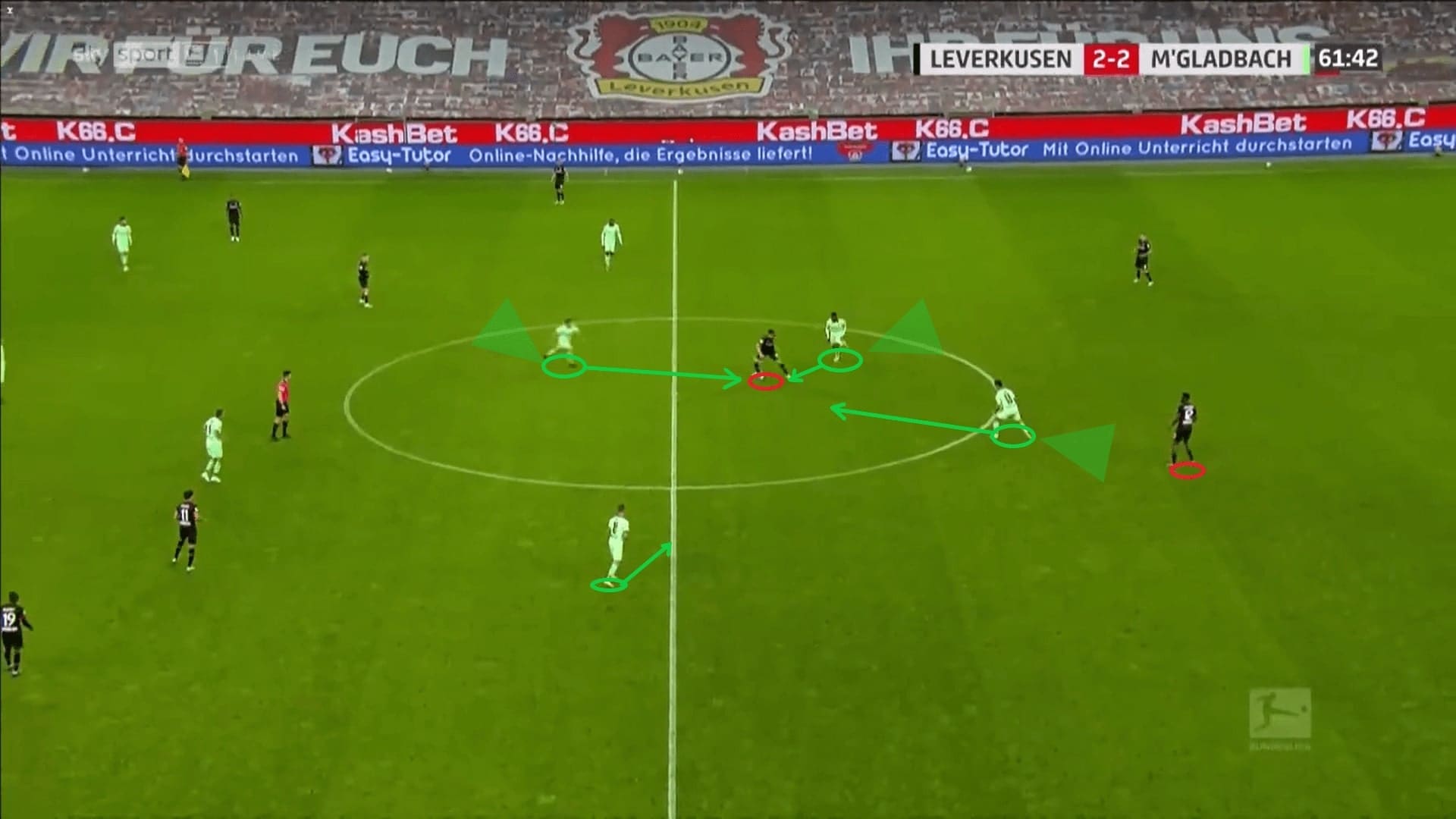
By the players supporting each other, Gladbach controlled spacing well to bait the opponent into a trap. This example shows a real situation in which the opposition was fallen into the trap.
The Leverkusen pivot is surrounded by three Gladbach players. Meanwhile, there was the fourth one, the narrow winger going inside to close the space if he dribbled to the only free direction. Most players in the world would not be able to escape from this.
And look at the pressing angles of the strikers – they shut all return passing lane to the centre-backs. It was because of their early attachment to the centre-backs. The blindside press from Kramer was the one that attacked the ball. Also, Kramer checked the opponent behind him before pressing, which allowed him to close the passing lane when approaching the opposition.
Therefore, we can conclude that the starting position when applying pressure is very important for Rose’s team. This is also why they need time to adjust to the right position before pressing, so the PPDA figure is not so low.
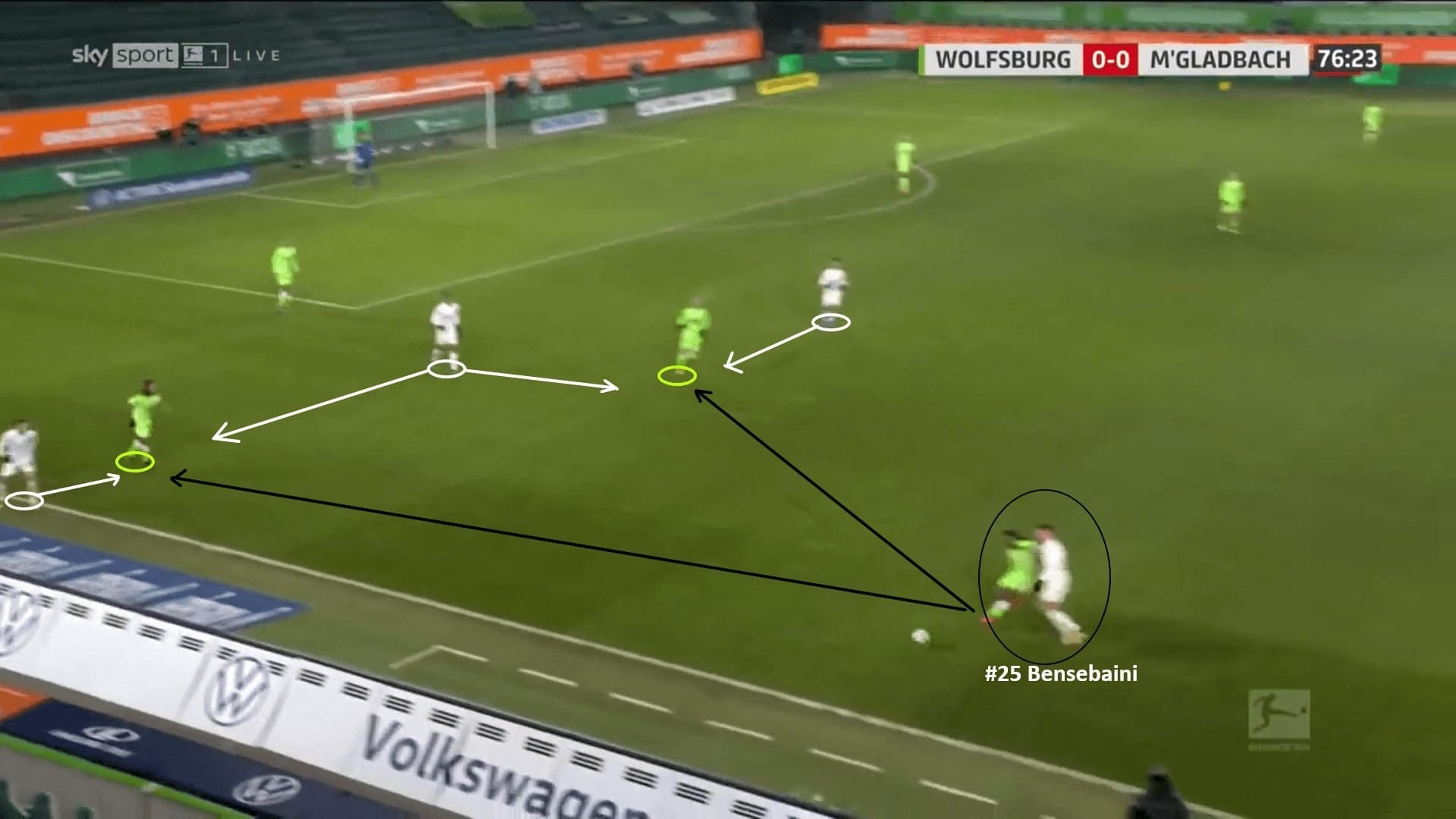
Passing to the wide zone is a trap but it carries some risks. Gladbach will need to be very careful and physical to win the ball back here, or else they would be exposed. The full-backs would be important in these scenarios. Their job is to stick tightly with the dropping wingers, not letting them turn and press the closed bodies.
Remi Bensebaini above must not let the receiver escapes or laying-off the ball, or else it would be risky. It was because after a lofted pass or wide pass is played, the Gladbach pressing players are suddenly in front of the ball. They must be quick to realize the potential third-man, stopping the third-man combinations. This is an aspect which they must improve.
If Gladbach won the ball here, they can have a counter-attack opportunity in the attacking third. If not, their high line and centre-backs are exposed.
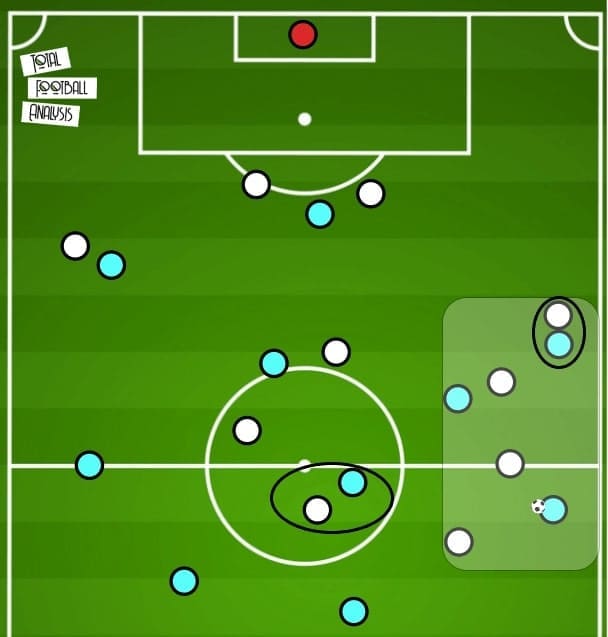
Another benefit to bait the pass into the wide zone is to make good use of the pressing structure. When moving out wide, as mentioned, Gladbach had four layers in a 4-2-2-2. When one player of each layer moved outside, they could close the flank by a “+1+ man advantage, as shown in the above picture. The circle on the top is the full-back, who should stay tight on the winger. The other three could be Kramer (MF), Thuram (WG), and Stindl (ST). Highlighted in white, the zone is closed in an extremely narrow shape, which is conducive for Rose’s men to press and win the ball back.
However, as circled at the centre, the task of covering the pivot should remain if possible.
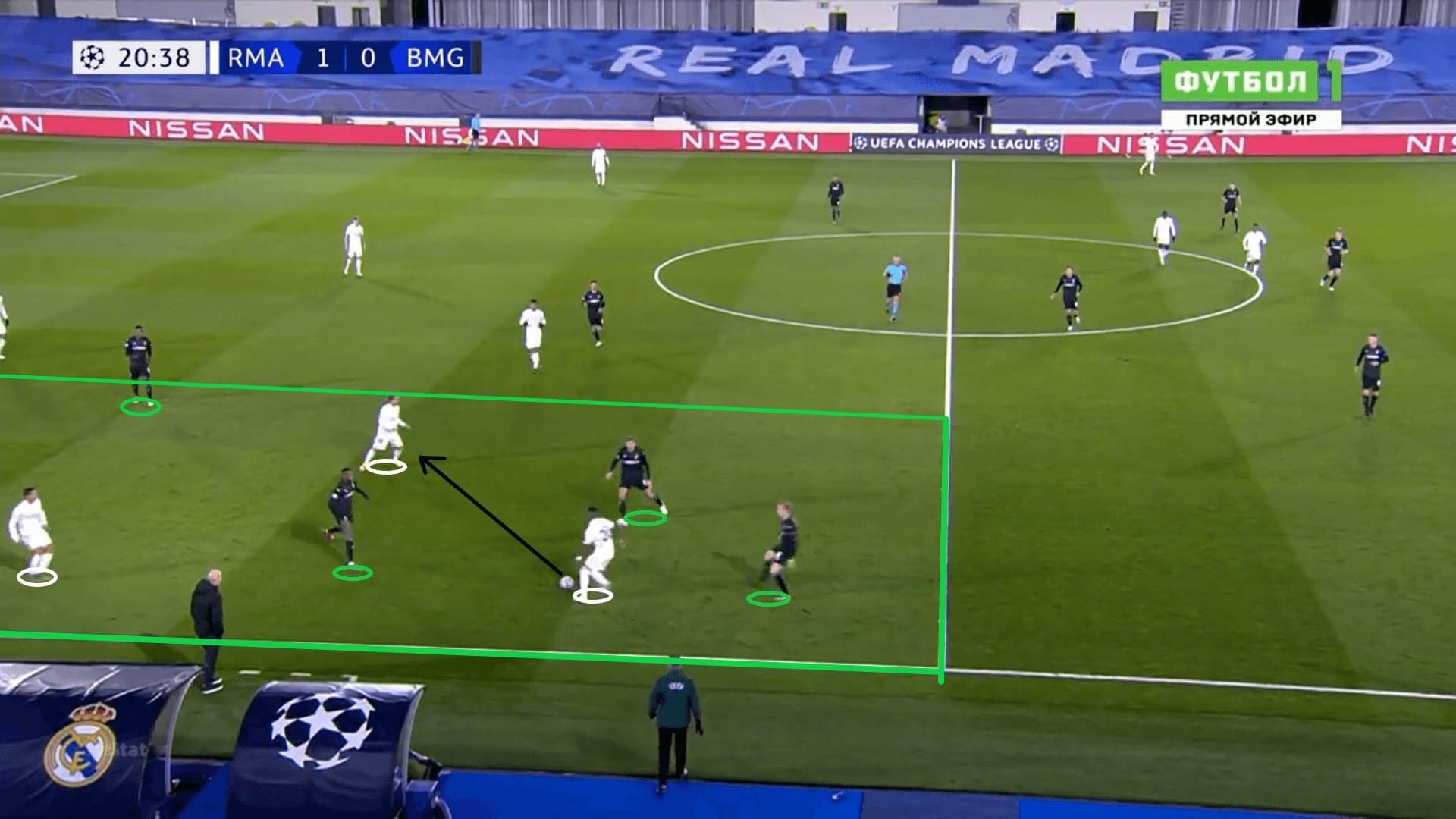
This image shows Gladbach executing this tactic in Spain against Madrid. They managed to create the 4v3 situation out wide because the left-back also joined the press. However, you could also see where Gladbach could improve – they are not attacking the ball! Even the winger dropped with a closed body, Oscar Wendt was nowhere near to attack him, which let them escape with a third-man play.
The situation was a bit of a mental issue as well, it seems that Gladbach sometimes needed more courage to play against big teams like Madrid and Manchester City in Europe.
Final remarks
Rose and his coaching staff are confirmed to be the next Dortmund manager in the summer, this type of strategical defence might not be appearing at Stadion im Borussia-Park in the future. However, his pressing philosophies were hugely inspirational for everyone, as we introduced them above, the use of a trap, ways to close spaces, shadowing passing lanes are the keys to success.
As shown in this tactical analysis, the defensive system of Gladbach also includes transitions considerations, which made them a more complete team with another way to score. This kind of mindset and their prowess in counter-attacks are going to fit Dortmund, we shall expect the same kind of football at SIGNAL IDUNA PARK.





Comments